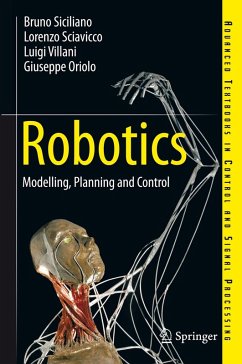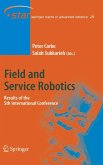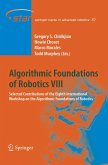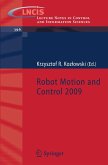The classic text on robot manipulators now covers visual control, motion planning and mobile robots too!
Robotics provides the basic know-how on the foundations of robotics: modelling, planning and control. The text develops around a core of consistent and rigorous formalism with fundamental and technological material giving rise naturally and with gradually increasing difficulty to more advanced considerations.
The theory of manipulator structures presented in the early part of the book encompasses:
. the fundamentals: kinematics, statics and trajectory planning; and
. the technology of actuators, sensors and control units.
Subsequently, more advanced instruction is given in:
. dynamics and motion control of robot manipulators;
. environmental interaction using exteroceptive sensory data (force and vision);
. mobile robots; and
. motion planning.
® code for computer problems; these are available free of charge to those adopting Robotics as a textbook for courses. This text is suitable for use in senior undergraduate and graduate courses in automation and computer, electrical, electronic and mechanical engineering courses with strong robotics content.
Robotics provides the basic know-how on the foundations of robotics: modelling, planning and control. The text develops around a core of consistent and rigorous formalism with fundamental and technological material giving rise naturally and with gradually increasing difficulty to more advanced considerations.
The theory of manipulator structures presented in the early part of the book encompasses:
. the fundamentals: kinematics, statics and trajectory planning; and
. the technology of actuators, sensors and control units.
Subsequently, more advanced instruction is given in:
. dynamics and motion control of robot manipulators;
. environmental interaction using exteroceptive sensory data (force and vision);
. mobile robots; and
. motion planning.
Dieser Download kann aus rechtlichen Gründen nur mit Rechnungsadresse in A, B, BG, CY, CZ, D, DK, EW, E, FIN, F, GR, HR, H, IRL, I, LT, L, LR, M, NL, PL, P, R, S, SLO, SK ausgeliefert werden.
"Robotics: Modelling, Planning and Control is a book that comprehensively covers all aspects of robotic fundamentals. It is particularly an excellent text for graduate educators, as it covers the fundamentals of the field with a rigorous formalism that is well blended with the technological aspects of robotics. The text covers in detail the theory of manipulators and wheeled robots starting with kinematics, dynamics and motion control, as well interaction with the environment through perception - force and vision sensors. The book is written by technical authorities in the field, and will be in invaluable addition to graduate education as well as a useful guide for industrial practitioners." -- Alexander Zelinsky, CSIRO, Australia
"Robotics is a diverse field bringing together disparate areas from computer science, electrical engineering and mechanical engineering. This book is an integrative but rigorous treatment of all the relevant concepts, with an eye toward modern, practical applications making it an excellent choice for a first year graduate course in robotics." -- Vijay Kumar, University of Pennsylvania
"This book provides rock-solid foundations for the study of classical mechanics and control of robots, with the authoritative character of a reference where you can surely find the correct expression and the rigorous derivation of the results you need. On top of this, new chapters on motion planning, visual servoing, and mobile robot control provide support to teaching wider and more interdisciplinary aspects of robotics, and open up vistas that will certainly inspire a new generation of scholars to embrace this incredibly rich and fertile research field." -- Antonio Bicchi, University of Pisa, Italy
"This book offers a well-balanced and intellectually satisfying treatment of robot mechanics, planning, and control - from the choice and sequence of topics, to the level of detail in the analysis, and the clear connections made between the latest technologies and the theoretical foundations of robotics, this book is an essential element in the library of every aspiring young robotics researcher." -- Frank Chongwoo Park, Seoul National University
"Robotics: Modeling, Planning and Control is a historiography from the materialistic view of robotics. Authors clearly explain physical and mathematical foundation to understand the most up-to-date robotics, so faithfully to bibliography and terminology in robotics. Unquestionably, the best textbook for senior students and graduate students and the closest reference book for engineers and scientists!" -- Yoshihiko Nakamura, University of Tokyo
"Exceptional! A text with such a span of robotics fundamentals and advanced research in both manipulation and mobility, and a treatment that creatively balances mathematical depth and physical intuition - a fresh and certainly unique reference for researchers and engineers in the field of robotics." -- Oussama Khatib, Stanford University
"Certainly because of its youth, robotics is not always considered as a discipline as such. It is often introduced as a technological "area" integrating various aspects of mechanics, automatic control and computer science. Such a dispersed view is prejudicial for students. The book by Siciliano et al. achieves the introduction of the basic concepts in a coherent, self-contained and didactic way. In that sense, when reading Robotics: Modelling, Planning and Control the reader - from the undergraduate student to the researcher - understands that a new discipline is born, with its own foundations." -- Jean-Paul Laumond, LAAS-CNRS
"Robotics is a diverse field bringing together disparate areas from computer science, electrical engineering and mechanical engineering. This book is an integrative but rigorous treatment of all the relevant concepts, with an eye toward modern, practical applications making it an excellent choice for a first year graduate course in robotics." -- Vijay Kumar, University of Pennsylvania
"This book provides rock-solid foundations for the study of classical mechanics and control of robots, with the authoritative character of a reference where you can surely find the correct expression and the rigorous derivation of the results you need. On top of this, new chapters on motion planning, visual servoing, and mobile robot control provide support to teaching wider and more interdisciplinary aspects of robotics, and open up vistas that will certainly inspire a new generation of scholars to embrace this incredibly rich and fertile research field." -- Antonio Bicchi, University of Pisa, Italy
"This book offers a well-balanced and intellectually satisfying treatment of robot mechanics, planning, and control - from the choice and sequence of topics, to the level of detail in the analysis, and the clear connections made between the latest technologies and the theoretical foundations of robotics, this book is an essential element in the library of every aspiring young robotics researcher." -- Frank Chongwoo Park, Seoul National University
"Robotics: Modeling, Planning and Control is a historiography from the materialistic view of robotics. Authors clearly explain physical and mathematical foundation to understand the most up-to-date robotics, so faithfully to bibliography and terminology in robotics. Unquestionably, the best textbook for senior students and graduate students and the closest reference book for engineers and scientists!" -- Yoshihiko Nakamura, University of Tokyo
"Exceptional! A text with such a span of robotics fundamentals and advanced research in both manipulation and mobility, and a treatment that creatively balances mathematical depth and physical intuition - a fresh and certainly unique reference for researchers and engineers in the field of robotics." -- Oussama Khatib, Stanford University
"Certainly because of its youth, robotics is not always considered as a discipline as such. It is often introduced as a technological "area" integrating various aspects of mechanics, automatic control and computer science. Such a dispersed view is prejudicial for students. The book by Siciliano et al. achieves the introduction of the basic concepts in a coherent, self-contained and didactic way. In that sense, when reading Robotics: Modelling, Planning and Control the reader - from the undergraduate student to the researcher - understands that a new discipline is born, with its own foundations." -- Jean-Paul Laumond, LAAS-CNRS
Robotics: Modelling, Planning and Control is a book that comprehensively covers all aspects of robotic fundamentals. It is particularly an excellent text for graduate educators, as it covers the fundamentals of the field with a rigorous formalism that is well blended with the technological aspects of robotics. The text covers in detail the theory of manipulators and wheeled robots starting with kinematics, dynamics and motion control, as well interaction with the environment through perception - force and vision sensors. The book is written by technical authorities in the field, and will be in invaluable addition to graduate education as well as a useful guide for industrial practitioners.
Alexander Zelinsky, CSIRO, Australia
Robotics is a diverse field bringing together disparate areas from computer science, electrical engineering and mechanical engineering. This book is an integrative but rigorous treatment of all the relevant concepts, with aneye toward modern, practical applications making it an excellent choice for a first year graduate course in robotics.
Vijay Kumar, University of Pennsylvania
This book provides rock-solid foundations for the study of classical mechanics and control of robots, with the authoritative character of a reference where you can surely find the correct expression and the rigorous derivation of the results you need. On top of this, new chapters on motion planning, visual servoing, and mobile robot control provide support to teaching wider and more interdisciplinary aspects of robotics, and open up vistas that will certainly inspire a new generation of scholars to embrace this incredibly rich and fertile research field.
Antonio Bicchi, University of Pisa, Italy
This book offers a well-balanced and intellectually satisfying treatment of robot mechanics, planning, and control - from the choice and sequence of topics, to the level of detail inthe analysis, and the clear connections made between the latest technologies and the theoretical foundations of robotics, this book is an essential element in the library of every aspiring young robotics researcher.
Frank Chongwoo Park, Seoul National University
Robotics: Modeling, Planning and Control is a historiography from the materialistic view of robotics. Authors clearly explain physical and mathematical foundation to understand the most up-to-date robotics, so faithfully to bibliography and terminology in robotics. Unquestionably, the best textbook for senior students and graduate students and the closest reference book for engineers and scientists!
Yoshihiko Nakamura, University of Tokyo
Exceptional! A text with such a span of robotics fundamentals and advanced research in both manipulation and mobility, and a treatment that creatively balances mathematical depth and physical intuition - a fresh and certainly unique reference for researchers and engineers in the field of robotics.
Oussama Khatib, Stanford University
Certainly because of its youth, robotics is not always considered as a discipline as such. It is often introduced as a technological "area" integrating various aspects of mechanics, automatic control and computer science. Such a dispersed view is prejudicial for students. The book by Siciliano et al. achieves the introduction of the basic concepts in a coherent, self-contained and didactic way. In that sense, when reading Robotics: Modelling, Planning and Control the reader - from the undergraduate student to the researcher - understands that a new discipline is born, with its own foundations.
Jean-Paul Laumond, LAAS-CNRS
Alexander Zelinsky, CSIRO, Australia
Robotics is a diverse field bringing together disparate areas from computer science, electrical engineering and mechanical engineering. This book is an integrative but rigorous treatment of all the relevant concepts, with aneye toward modern, practical applications making it an excellent choice for a first year graduate course in robotics.
Vijay Kumar, University of Pennsylvania
This book provides rock-solid foundations for the study of classical mechanics and control of robots, with the authoritative character of a reference where you can surely find the correct expression and the rigorous derivation of the results you need. On top of this, new chapters on motion planning, visual servoing, and mobile robot control provide support to teaching wider and more interdisciplinary aspects of robotics, and open up vistas that will certainly inspire a new generation of scholars to embrace this incredibly rich and fertile research field.
Antonio Bicchi, University of Pisa, Italy
This book offers a well-balanced and intellectually satisfying treatment of robot mechanics, planning, and control - from the choice and sequence of topics, to the level of detail inthe analysis, and the clear connections made between the latest technologies and the theoretical foundations of robotics, this book is an essential element in the library of every aspiring young robotics researcher.
Frank Chongwoo Park, Seoul National University
Robotics: Modeling, Planning and Control is a historiography from the materialistic view of robotics. Authors clearly explain physical and mathematical foundation to understand the most up-to-date robotics, so faithfully to bibliography and terminology in robotics. Unquestionably, the best textbook for senior students and graduate students and the closest reference book for engineers and scientists!
Yoshihiko Nakamura, University of Tokyo
Exceptional! A text with such a span of robotics fundamentals and advanced research in both manipulation and mobility, and a treatment that creatively balances mathematical depth and physical intuition - a fresh and certainly unique reference for researchers and engineers in the field of robotics.
Oussama Khatib, Stanford University
Certainly because of its youth, robotics is not always considered as a discipline as such. It is often introduced as a technological "area" integrating various aspects of mechanics, automatic control and computer science. Such a dispersed view is prejudicial for students. The book by Siciliano et al. achieves the introduction of the basic concepts in a coherent, self-contained and didactic way. In that sense, when reading Robotics: Modelling, Planning and Control the reader - from the undergraduate student to the researcher - understands that a new discipline is born, with its own foundations.
Jean-Paul Laumond, LAAS-CNRS
Robotics: Modelling, Planning and Control is a book that comprehensively covers all aspects of robotic fundamentals. It is particularly an excellent text for graduate educators, as it covers the fundamentals of the field with a rigorous formalism that is well blended with the technological aspects of robotics. The text covers in detail the theory of manipulators and wheeled robots starting with kinematics, dynamics and motion control, as well interaction with the environment through perception - force and vision sensors. The book is written by technical authorities in the field, and will be in invaluable addition to graduate education as well as a useful guide for industrial practitioners. Alexander Zelinsky, CSIRO, Australia Robotics is a diverse field bringing together disparate areas from computer science, electrical engineering and mechanical engineering. This book is an integrative but rigorous treatment of all the relevant concepts, with an eye toward modern, practical applications making it an excellent choice for a first year graduate course in robotics. Vijay Kumar, University of Pennsylvania This book provides rock-solid foundations for the study of classical mechanics and control of robots, with the authoritative character of a reference where you can surely find the correct expression and the rigorous derivation of the results you need. On top of this, new chapters on motion planning, visual servoing, and mobile robot control provide support to teaching wider and more interdisciplinary aspects of robotics, and open up vistas that will certainly inspire a new generation of scholars to embrace this incredibly rich and fertile research field. Antonio Bicchi, University of Pisa, Italy This book offers a well-balanced and intellectually satisfying treatment of robot mechanics, planning, and control - from the choice and sequence of topics, to the level of detail in the analysis, and the clear connections made between the latest technologies and the theoretical foundations of robotics, this book is an essential element in the library of every aspiring young robotics researcher. Frank Chongwoo Park, Seoul National University Robotics: Modeling, Planning and Control is a historiography from the materialistic view of robotics. Authors clearly explain physical and mathematical foundation to understand the most up-to-date robotics, so faithfully to bibliography and terminology in robotics. Unquestionably, the best textbook for senior students and graduate students and the closest reference book for engineers and scientists! Yoshihiko Nakamura, University of Tokyo Exceptional! A text with such a span of robotics fundamentals and advanced research in both manipulation and mobility, and a treatment that creatively balances mathematical depth and physical intuition - a fresh and certainly unique reference for researchers and engineers in the field of robotics. Oussama Khatib, Stanford University Certainly because of its youth, robotics is not always considered as a discipline as such. It is often introduced as a technological "area" integrating various aspects of mechanics, automatic control and computer science. Such a dispersed view is prejudicial for students. The book by Siciliano et al. achieves the introduction of the basic concepts in a coherent, self-contained and didactic way. In that sense, when reading Robotics: Modelling, Planning and Control the reader - from the undergraduate student to the researcher - understands that a new discipline is born, with its own foundations. Jean-Paul Laumond, LAAS-CNRS









